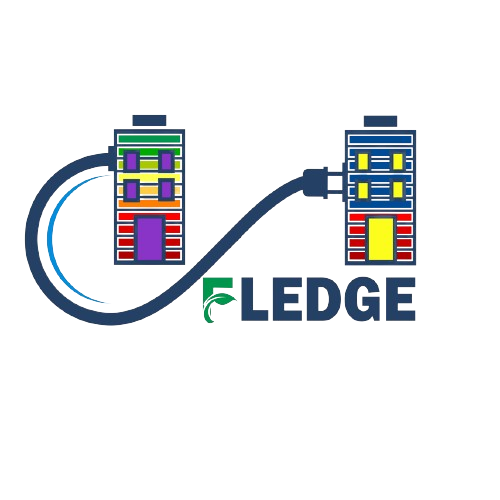
About
Project Vision for FLEdge
The vision of the FLEdge project is to develop an advanced, hierarchical energy management system based on a distributed and decentralized architecture. This system, centered around the innovative Edge-Energy Management (EEM) device, aims to manage energy flexibility in an automatic, optimal, and decentralized manner. By integrating this technology into buildings, neighborhoods, districts, and entire cities, the project aspires to transform these areas into Positive Energy Districts (PEDs).
Key elements of the FLEdge’s vision include:
- Decentralized Energy Management: Utilizing the EEM device, which processes local data from buildings to optimize energy sources like renewable energy systems (RES), storage, and loads. This approach ensures energy efficiency and flexibility at the local level.
- Human-Centric Design: Prioritizing the well-being and comfort of residents, the EEM device will include an intelligent Decision Support System (DSS) to optimize building management tasks such as load shifting, dimming, pre-heating, and pre-cooling.
- Scalable and Interoperable Solutions: Implementing EEM and Energy Management Nodes (EMaN) at various levels (neighborhood, district, city) to enhance performance and support the development of smart and green cities.
- Sustainability and Energy Efficiency: Driving towards significant reductions in greenhouse gas emissions and increased reliance on renewable energy, supporting the EU’s ambitious targets for 2030 and beyond.
This comprehensive approach will not only contribute to immediate energy efficiency improvements but will also set a foundation for future innovations and expansions in energy management technologies.

Objectives of the FLEdge Project
1. Develop a Hierarchical Flexibility Energy Management System: Create a distributed and decentralized architecture with the core element being the Edge-Energy Management (EEM) device. This device will manage energy flexibility automatically, optimally, and in a decentralized manner to transform buildings, neighborhoods, districts, and cities into Positive Energy Districts (PEDs) .
2. Optimize Energy Resources: Process local heterogeneous information from buildings for energy sources optimization, including renewable energy systems (RES), storage, and load management. Equip the EEM with an intelligent Decision Support System (DSS) to automate building management tasks such as load shifting, dimming, pre-heating, and pre-cooling .
3. Enhance Human Well-being and Comfort: Ensure that all operations aim to enhance the well-being and comfort of residents, making FLEdge a human-centric project .
4. Implement Demand/Response (D/R) Strategies: Develop EMaN nodes at neighborhood, district, and city levels to manage flexibility and implement D/R actions, enhancing grid stability and achieving zero-net emissions .
5. Ensure Energy Security and Prevent Energy Poverty: Develop algorithms for energy forecasting and D/R optimization to reduce energy costs and ensure energy security, contributing to the prevention of energy poverty .
6. Innovate in Energy Flexibility Solutions: Design and implement innovative solutions for energy flexibility strategies, integrating advanced technologies like AI, IoT, and Digital Twins to create smart, decarbonized urban environments.

Architecture
The FLEdge project architecture is organized in a hierarchical manner to effectively manage energy at different levels, from individual buildings to entire cities. It features Energy Management Nodes (EMaN) and Edge-Energy Management (EEM) devices, which work together to optimize energy usage and flexibility.
1. City Level:
– At the top of the hierarchy is the Energy Management Node (EMaN) device at the city level. This node is responsible for overseeing and managing the energy needs and resources of the entire city.
2. District Level:
– Below the city level are Energy Management Node (EMaN) devices at the district level. Each district level EMaN device manages the energy resources and needs of a specific district within the city. These nodes aggregate data from multiple neighborhood level nodes and provide a coordinated approach to energy management across districts.
3. Neighborhood Level:
– The next level down is the Energy Management Node (EMaN) devices at the neighborhood level. These nodes manage energy at a more localized level, gathering data from various EEM devices within the neighborhood and optimizing energy usage for the entire neighborhood.
4. Building Level (EEM Devices):
– At the bottom of the hierarchy are the Edge-Energy Management (EEM) devices installed in individual buildings. These devices are equipped with various functions to gather and process local energy data:
– Predictions: Energy consumption and generation forecasting.
– Data Gathering: Collecting information on energy consumption and generation at the building level.
– Energy Disaggregation: Breaking down energy usage by different appliances and systems.
– Energy Prices: Monitoring and responding to energy price signals.
– Occupancy Estimation: Estimating the occupancy levels to optimize energy usage.
– Comfort Estimation: Ensuring optimal comfort levels for the building’s occupants.
– Demand/Response Strategies: Implementing strategies to shift or reduce energy demand based on external signals.
– Decision Support System (DSS): Providing intelligent decision-making support for energy management tasks such as load shifting, dimming, pre-heating, and pre-cooling.
This hierarchical architecture ensures a scalable, flexible, and efficient approach to energy management, enabling the transformation of buildings, neighbourhoods, districts, and cities into sustainable, energy-efficient environments.

